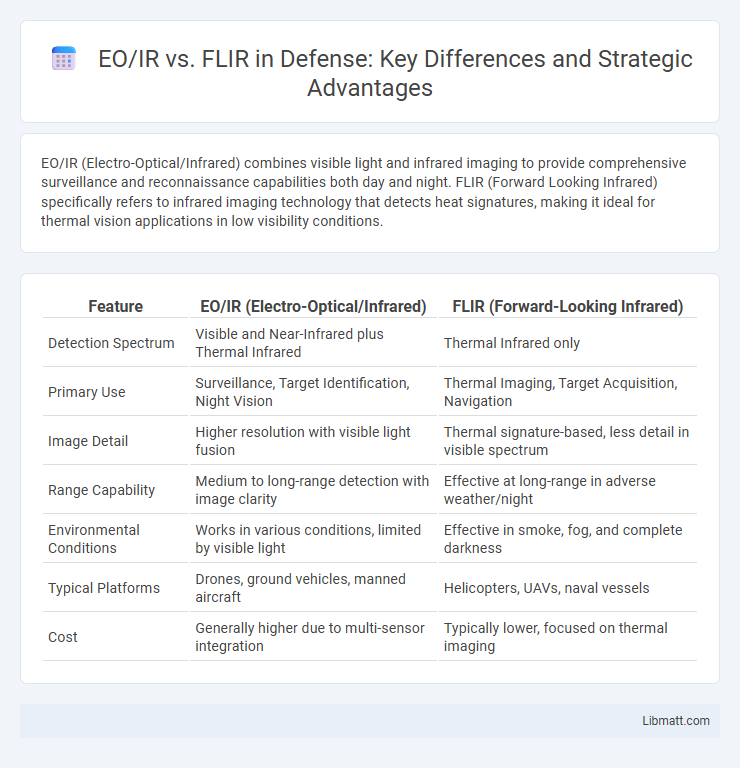EO/IR (Electro-Optical/Infrared) combines visible light and infrared imaging to provide comprehensive surveillance and reconnaissance capabilities both day and night. FLIR (Forward Looking Infrared) specifically refers to infrared imaging technology that detects heat signatures, making it ideal for thermal vision applications in low visibility conditions.
Table of Comparison
| Feature | EO/IR (Electro-Optical/Infrared) | FLIR (Forward-Looking Infrared) |
|---|---|---|
| Detection Spectrum | Visible and Near-Infrared plus Thermal Infrared | Thermal Infrared only |
| Primary Use | Surveillance, Target Identification, Night Vision | Thermal Imaging, Target Acquisition, Navigation |
| Image Detail | Higher resolution with visible light fusion | Thermal signature-based, less detail in visible spectrum |
| Range Capability | Medium to long-range detection with image clarity | Effective at long-range in adverse weather/night |
| Environmental Conditions | Works in various conditions, limited by visible light | Effective in smoke, fog, and complete darkness |
| Typical Platforms | Drones, ground vehicles, manned aircraft | Helicopters, UAVs, naval vessels |
| Cost | Generally higher due to multi-sensor integration | Typically lower, focused on thermal imaging |
Introduction to EO/IR and FLIR Technologies
EO/IR technology combines Electro-Optical (EO) sensors that capture visible light images with Infrared (IR) sensors detecting thermal radiation, enabling comprehensive surveillance and targeting capabilities in diverse environments. FLIR, or Forward-Looking Infrared, is a specialized type of IR sensor designed primarily for real-time thermal imaging in navigation, reconnaissance, and security systems. Your understanding of EO/IR versus FLIR helps optimize the choice between multi-spectrum detection technologies for enhanced situational awareness.
Defining EO/IR: Key Features and Capabilities
EO/IR systems combine Electro-Optical (EO) and Infrared (IR) sensors to provide comprehensive imaging capabilities across both visible and thermal spectra. These systems excel at detecting, identifying, and tracking targets in diverse environmental conditions, including complete darkness and obscured visibility. Your operational effectiveness is enhanced by EO/IR's ability to deliver real-time, high-resolution images for surveillance, reconnaissance, and targeting applications.
What is FLIR? Fundamentals and Applications
FLIR (Forward Looking Infrared) is a type of EO/IR (Electro-Optical/Infrared) technology that captures thermal infrared radiation to create detailed images in low-visibility conditions such as darkness, smoke, or fog. FLIR systems detect heat signatures emitted by objects, enabling applications in military surveillance, search and rescue, firefighting, and industrial inspection. The fundamental principle of FLIR involves converting infrared radiation into electronic signals to form a thermal image, which can reveal temperature variations and hidden objects.
Core Differences Between EO/IR and FLIR
EO/IR systems combine Electro-Optical and Infrared technologies to capture both visible and thermal images, enhancing situational awareness across various lighting conditions. FLIR specifically refers to Forward-Looking Infrared technology that detects thermal radiation to create thermal images, primarily used for night vision and target detection. Understanding these core differences helps you choose the right sensor for applications requiring either comprehensive visual imaging or specialized thermal detection.
Imaging Performance: Day vs Night Operations
EO/IR systems combine Electro-Optical sensors for high-resolution daytime imaging with Infrared sensors that detect thermal radiation, enabling effective nighttime operation. FLIR technology specializes in capturing infrared radiation, providing superior thermal imaging capabilities essential for low-light or no-light conditions. While EO excels in detailed color imagery during the day, FLIR's thermal sensitivity ensures enhanced detection and identification of targets during night missions.
Military and Civilian Applications Compared
EO/IR (Electro-Optical/Infrared) systems and FLIR (Forward Looking Infrared) technology both play crucial roles in military and civilian applications, with EO/IR providing combined imaging capabilities in visible and infrared spectra for enhanced situational awareness. Military use of EO/IR focuses on target acquisition, surveillance, and reconnaissance with precise day-night functionality, while FLIR excels in thermal imaging to detect heat signatures in low-visibility conditions. Civilian applications of EO/IR and FLIR include search and rescue, firefighting, and security, offering your operations advanced detection tools to improve safety and efficiency.
Integration with Modern Surveillance Systems
EO/IR sensors and FLIR technology both play critical roles in modern surveillance systems, with EO/IR offering enhanced multispectral imaging capabilities that combine visible and infrared spectrums for comprehensive situational awareness. FLIR, a specific type of infrared technology, is widely integrated for thermal imaging to detect heat signatures in low-visibility conditions, making it indispensable for nighttime and obscured environment surveillance. Advanced surveillance platforms utilize EO/IR systems for real-time data fusion, enabling improved target identification, tracking, and threat assessment across diverse operational scenarios.
Cost and Maintenance Considerations
EO/IR systems typically have higher initial costs and maintenance expenses than FLIR systems due to their integration of electro-optical and infrared sensors, which require specialized calibration and servicing. FLIR technology, primarily focused on infrared thermal imaging, generally offers lower maintenance costs and simpler operational requirements, making it more cost-effective for long-term use. Budget considerations for EO/IR should factor in advanced repair processes and higher sensor replacement costs compared to the more established and widely available FLIR components.
Choosing the Right Solution: Factors to Evaluate
When choosing between EO/IR and FLIR systems, key factors to evaluate include operational environment, resolution requirements, and target detection range. EO/IR systems excel in multi-spectral imaging combining electro-optical cameras with infrared sensors for versatile applications, while FLIR focuses specifically on thermal imaging with high sensitivity to heat signatures. Budget constraints, maintenance needs, and integration capabilities with existing platforms also influence the optimal solution selection for surveillance, defense, or industrial use.
Future Trends in EO/IR and FLIR Technologies
Future trends in EO/IR and FLIR technologies emphasize enhanced resolution and sensitivity using advanced sensor arrays and AI-driven image processing. Integration of multispectral imaging with machine learning algorithms improves target detection and classification in complex environments. Miniaturization and increased power efficiency enable deployment on a wider range of unmanned aerial vehicles and portable platforms for real-time situational awareness.
EO/IR vs FLIR Infographic

 libmatt.com
libmatt.com